The industrial zones in Vietnam have been rising tremendously due to the substantial increase of foreign investments. The Vietnamese government continues to put in more efforts and draft a legal framework to boost the foreign contributions as well. This is an interesting thing to know for foreign entrepreneurs looking to establish businesses and engage in company registration in Vietnam.
The industrial and economic zones in Vietnam have attracted 7,500 domestic projects and 8,000 foreign projects. Domestic projects reached a total value of US$41.75 billion and foreign projects were worth over US$145 billion. According to the record as of December 2018 provided by the Ministry of Planning and Investment, 326 industrial zones have been established across the country, and 249 are in operation.
Although industrial zones in Vietnam are optimal for many investors for the growth of their capital, you are advised to do your own due diligence and learn more about each industrial zone you are interested in before you start with your company registration in Vietnam.
This article attempts to provide you with a quick guide to assist you in choosing an industrial zone with the right location for your business in Vietnam.

Vietnam Company Registration: Locations of Industrial Zone
In Vietnam, industrial zones are a remarkable investment vehicle for many foreign businesses. They are designated by the Vietnamese government to produce industrial goods and services, as well as to carry out export and hi-tech related activities. Businesses that are set up at an industrial zone get incentives provided by the government.
When talking about the locations of industrial zone in Vietnam, they are all over the country. In general, their locations can be categorized into three regions: North, South and Centre. Each region offers different benefits and incentives to investors.
The North Key Economic Zone (NKEZ)
Thanks to its proximity to China, NKEZ shows huge development in the past decade. Some notable cities include Hanoi, Bac Ninh, Hai Phong, Hai Duong, etc.
As part of the China plus one strategy, this region is suitable for companies considering moving their manufacturing operations from China to Vietnam, particularly in textile and garment manufacturing. Exports and agriculture industries are also popular here.
The Central Key Economic Zone (CKEZ)
CKEZ’s major provinces include Da Nang, Thua Thien Hue, Quang Nam, Binh Dinh and Quang Ngai. Major activities are focused in and around Da Nang with opportunities such as food processing, ship building, logistics, oil and gas, high-tech, light and marine industries.
The Southern Key Economic Zone (SKEZ)
This region includes Ho Chi Minh City, Dong Nai, Binh Duong, Long An, Tien Giang, etc. Areas around the Ho Chi Minh City are the industrial hub and have the most activities in Vietnam, contributing to the highest foreign direct investments.
SKEZ is suitable for furniture and footwear manufacturing, exports, services, technology, telecommunications and other commerce.
Provincial Competitiveness Index in 2018 showed that the top industrial zones in Vietnam were the following:
- Northern region: Quang Ninh
- Central region: Da Nang
- Southern region: Dong Thap, Long An ad Ben Tre
Incentives in Specialized Zones
Different incentives are available in specialized zones to enhance both foreign and domestic investments in Vietnam.
Sectors that are encouraged and eligible for these incentives include healthcare, education, high technology, sports, scientific research, culture, software manufacturing and infrastructural development.
These tax incentives offered by the Vietnamese government consist of the reductions or exemptions of the following taxes for specific periods:
- Corporate Income Tax (CIT)
- Value-Added Tax (VAT)
- Import tariffs
Talent and Wages in Different Industrial Zone Regions
One of the things that attract so many foreign investors in Vietnam is the country’s inexpensive labor and talent. Qualified workers are more competitive and abundant in the northern and southern regions, especially in Hanoi, Hai Phong, and Ho Chi Minh City. As for central region, it can be challenging to find the right workers for higher positions, especially in the technical and specialized fields.
Depending on the region, Vietnam may have different monthly minimum wages. Ho Chi Minh City and Hanoi tend to have higher minimum wages. Based on the skill levels, managers and industrial workers have an average salary varying from US$500 to US$2,000.
July 2020 Update: The minimum wage in Vietnam will be increased from 1,490,000 VND/month (US$63,8) to 1,600,000 VND/month (US$68,5), an increase of 110,000 VND and valid from July 1st, 2020. This is in accordance with Decree 86/2019/QH14 on Nov 12, 2019 about Government’s budget plan in 2020.





